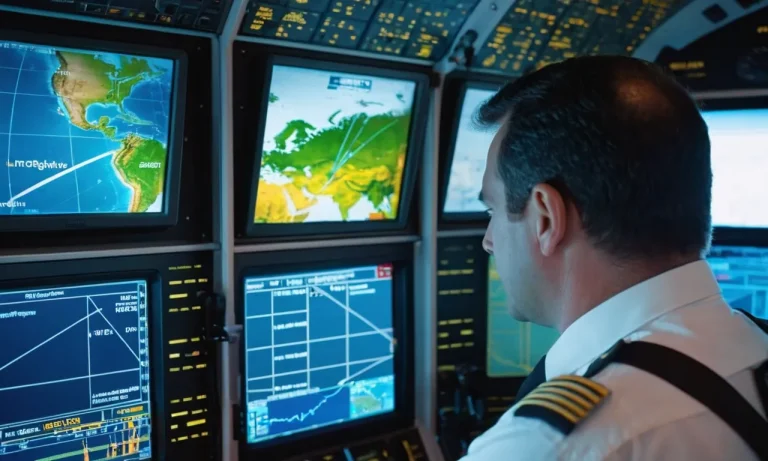How Much Wind Will Cancel A Flight?
Have you ever shown up at the airport only to find that your flight has been canceled due to windy conditions? Wind can significantly impact both takeoffs and landings, forcing airlines to proactively cancel flights when winds reach certain thresholds.
If you’re short on time, here’s a quick answer to your question: Airlines establish maximum allowable crosswind limits which vary by aircraft type, typically between 20 and 35 knots. Gusty winds beyond those thresholds may require flight cancellations or diversions to alternate airports.
In this comprehensive article, we’ll explore the intricate relationship between wind and commercial airline operations. You’ll learn how wind direction and speed can impact flight maneuvers and airport operations.
We’ll also look at how airlines determine maximum wind limits for their various aircraft and what factors cause winds to exceed those thresholds resulting in cancellations.
How Wind Direction and Speed Impact Flight Operations
Crosswinds During Takeoff and Landing
Wind direction and speed play a crucial role in flight operations, particularly during takeoff and landing. Crosswinds, which blow perpendicular to the direction of the runway, can pose significant challenges for pilots.
When the wind speed exceeds a certain threshold, it can make it difficult for pilots to maintain control of the aircraft during these critical phases of flight.
During takeoff, crosswinds can cause the aircraft to drift off course, making it harder for the pilot to keep the aircraft aligned with the runway centerline. This can result in a longer takeoff roll or even a runway excursion, which is when the aircraft departs the paved surface of the runway.
Similarly, during landing, crosswinds can create a crabbing effect, where the aircraft is pointed slightly into the wind to counteract the sideways force. This technique, known as “crabbing,” allows the aircraft to maintain its alignment with the runway as it touches down.
However, if the crosswind is too strong, the pilot may need to perform a crosswind landing, also known as a “sideslip” or “slip.” In a crosswind landing, the pilot intentionally banks the aircraft into the wind, using the rudder to keep the aircraft aligned with the runway.
This technique requires skill and precision, as the pilot must carefully manage the aircraft’s bank angle and descent rate to ensure a safe landing.
Headwinds and Tailwinds In Cruise
While crosswinds primarily affect takeoff and landing, headwinds and tailwinds have an impact on flight operations during the cruise phase. Headwinds are winds blowing directly against the aircraft’s forward motion, while tailwinds blow in the same direction as the aircraft’s flight path.
Headwinds can slow down the aircraft’s groundspeed, meaning it takes longer to reach the destination. This can result in extended flight times and increased fuel consumption. On the other hand, tailwinds can boost the aircraft’s groundspeed, allowing it to cover more distance in a shorter amount of time.
This can lead to shorter flight durations and potentially lower fuel consumption.
Pilots and flight planners take wind speed and direction into account when calculating the fuel requirements and flight plans. They consider the expected wind conditions along the route to optimize the aircraft’s performance and ensure sufficient fuel reserves.
It’s important to note that while wind conditions can impact flight operations, modern aircraft are designed to handle a wide range of wind speeds and directions. Aviation authorities, such as the Federal Aviation Administration (FAA) and the International Civil Aviation Organization (ICAO), set guidelines and limitations for wind conditions to ensure safe operations.
For more detailed information on how wind affects flight operations, you can refer to the FAA’s official website or the ICAO’s official website. These authoritative sources provide comprehensive information on aviation regulations and safety practices.
Aircraft Maximum Crosswind Limits and Wind Constraints
When it comes to flying, wind conditions play a crucial role in determining whether a flight can proceed safely. Strong crosswinds, in particular, can pose a significant challenge for pilots during takeoff and landing.
To ensure the safety of passengers and crew, aircraft have specific maximum crosswind limits and wind constraints that must be adhered to.
Variation By Aircraft Type and Runway Conditions
The maximum crosswind limits can vary depending on the type of aircraft and the conditions of the runway. Different aircraft have different capabilities to handle crosswinds, and manufacturers provide guidance on the maximum crosswind component that their aircraft can safely operate in.
Runway conditions, such as the presence of ice or snow, can also affect the maximum crosswind limits.
For example, larger commercial aircraft like Boeing 747 or Airbus A380 are generally more stable in crosswinds compared to smaller regional jets. Runways equipped with crosswind runways or advanced technology, such as grooved surfaces or wind monitoring systems, can increase the maximum crosswind limits for aircraft.
Wind Limits Set by Manufacturers and Airlines
Aircraft manufacturers, in collaboration with regulatory authorities, set the maximum crosswind limits for their aircraft. These limits are based on extensive testing and simulations to ensure the safe operation of the aircraft under various wind conditions.
The limits take into account factors such as aircraft design, stability, and control characteristics.
In addition to the manufacturer’s limits, airlines may have their own specific policies and wind constraints. These constraints can be more conservative than the manufacturer’s limits to account for factors such as pilot proficiency, airline operating procedures, and passenger comfort.
It’s important to note that these limits are not arbitrary; they are based on rigorous engineering and safety considerations. Pilots receive specialized training to handle crosswind conditions and are trained to make informed decisions based on the aircraft’s capabilities and the prevailing wind conditions.
For more information on aircraft maximum crosswind limits and wind constraints, you can refer to the websites of aircraft manufacturers like Boeing or Airbus, as well as the regulatory authorities like the Federal Aviation Administration (FAA) or the European Aviation Safety Agency (EASA).
Why Strong Winds Cause Flight Cancellations
Strong winds can often lead to flight cancellations and disruptions. Airlines prioritize passenger safety above all else, and adverse weather conditions, particularly strong winds, can pose significant risks to aircraft operations.
Here are some reasons why strong winds can result in flight cancellations:
Exceeding Established Aircraft Limits
Every aircraft has specific limits set by its manufacturer that dictate the maximum crosswind component it can safely handle during takeoff and landing. The crosswind component refers to the wind blowing across the runway.
If the wind exceeds the aircraft’s established limits, it can make it difficult for pilots to maintain control during critical phases of flight, such as takeoff and landing. In such cases, airlines may opt to cancel or delay flights to ensure the safety of passengers and crew.
Low Visibility and Wind Shear Concerns
In addition to crosswinds, strong winds can also result in low visibility and wind shear, which can create hazardous conditions for aircraft. Low visibility caused by strong winds can make it challenging for pilots to see the runway, other aircraft, or important navigational aids.
Wind shear refers to sudden changes in wind speed and direction, which can cause abrupt shifts in the aircraft’s performance. These unpredictable changes can make it difficult for pilots to maintain stable flight and increase the risk of accidents.
Airlines closely monitor weather conditions, including wind shear and low visibility, and may cancel flights to ensure the safety of passengers and crew.
Impacts of Gusty and Unpredictable Winds
Gusty and unpredictable winds can also pose a threat to aircraft operations. Strong gusts can create turbulence, causing discomfort for passengers and potentially affecting the stability of the aircraft.
Additionally, rapid changes in wind direction and intensity can make it challenging for pilots to navigate and land safely. To mitigate the risks associated with gusty and unpredictable winds, airlines may choose to cancel or divert flights to avoid potential hazards.
The decision to cancel a flight due to strong winds is made with the intention of ensuring the safety of everyone on board.
How Airlines Monitor and Prepare For Wind Events
When it comes to wind events, airlines take the safety and comfort of their passengers very seriously. They have comprehensive systems in place to monitor and prepare for potential disruptions caused by strong winds. Here are some of the ways airlines stay ahead of the game:
Advance Weather Forecasting and Modeling
Airlines rely on advanced weather forecasting and modeling techniques to predict wind patterns with a high degree of accuracy. They work closely with meteorological experts and use sophisticated computer models to analyze various weather data, including wind speed and direction.
By understanding how wind patterns may evolve, airlines can anticipate potential flight disruptions and take proactive measures to minimize any impact on passengers.
Airport Wind Direction and Speed Measurements
Airports play a crucial role in monitoring wind conditions, as they have instruments in place to measure wind direction and speed. Windsocks and anemometers are commonly used to provide real-time information about wind conditions on the airfield.
Airlines have access to this data and closely monitor any changes in wind conditions that could affect flight operations. By having this information readily available, airlines can make informed decisions about whether to delay, divert, or cancel flights in the event of strong winds.
Strategic Planning to Minimize Passenger Disruptions
Airlines have strategic plans in place to minimize disruptions to their passengers in the face of strong winds. These plans involve close coordination with air traffic control, ground operations, and other relevant stakeholders.
Airlines may choose to adjust flight routes, change departure times, or even cancel flights if necessary to ensure passenger safety. The goal is to minimize the inconvenience caused by strong winds while prioritizing the safety and well-being of passengers.
Passenger Options For Rebooking Wind-Impacted Flights
Rebooking on Alternate Flights
When flights are canceled or delayed due to high winds, airlines typically offer passengers the option to rebook on alternate flights. This allows passengers to reach their destination as close to their original schedule as possible.
Airlines will usually provide a list of available flights and allow passengers to choose the one that best suits their needs. It’s important to act quickly and contact the airline as soon as you receive notification of a flight cancellation or delay, as availability on alternate flights can fill up quickly.
Passengers can contact the airline directly via phone or check the airline’s website for rebooking options. Some airlines also offer mobile apps that allow passengers to easily manage their flights and rebook in case of disruptions.
It’s a good idea to have your booking reference or ticket number on hand when contacting the airline to expedite the rebooking process.
Receiving Travel Vouchers or Refunds
In certain cases, when flights are canceled due to high winds, airlines may offer travel vouchers or refunds to affected passengers. These vouchers can be used towards future flights with the same airline.
The value of the vouchers can vary depending on the airline’s policies and the specific circumstances of the flight cancellation.
Passengers should inquire with the airline about the possibility of receiving travel vouchers or refunds when their flight is canceled or significantly delayed due to high winds. It’s important to note that not all airlines may offer this option, so it’s best to check with the specific airline you are flying with.
Using Customer Flexibility Policies
Many airlines have customer flexibility policies in place that allow passengers to make changes to their travel plans without incurring additional fees or penalties. These policies may include provisions for flight cancellations or delays caused by high winds.
Passengers can take advantage of these policies to reschedule their flights to a more convenient time or even change their destination if necessary.
It’s advisable to familiarize yourself with the customer flexibility policies of the airline you are flying with before your trip. This way, you’ll be aware of the options available to you in case your flight is impacted by high winds or other unforeseen circumstances.
These policies can vary from airline to airline, so it’s always a good idea to review them prior to your travel date.
Conclusion
Wind plays a pivotal role in flight cancellations, with gusty winds outside of manufacturer tolerances frequently grounding flights. Airlines utilize in-depth weather data and planning to anticipate major wind events well in advance to proactively cancel impacted flights.
By understanding aircraft limitations and how carriers handle wind disruptions, passengers can better navigate rebooking options when the winds start howling.








